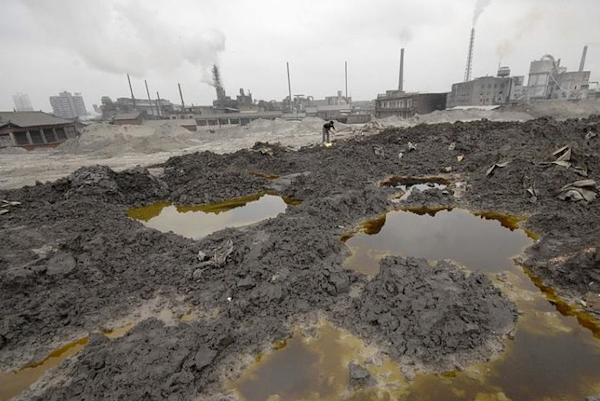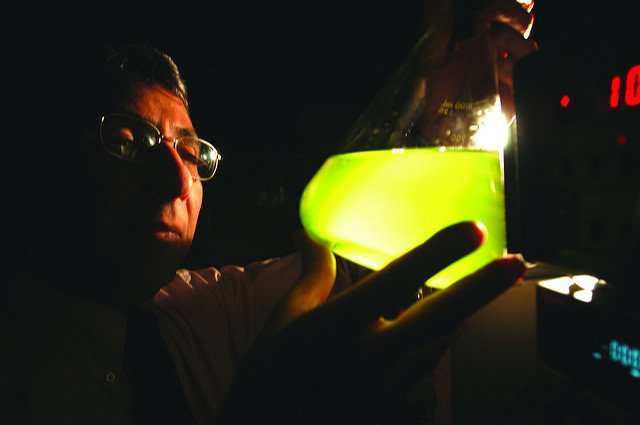Microorganisms as Biosensors
Pesticides, Herbicides, Shipwrecks, Waste dumping, PCBs from transformer oils, insecticides, sewage used as manure, oil rigs, sewage outfalls….
There is something peculiar associated with all of the above processes and chemicals, and that is environmental pollution.

Contaminated Soil
Our loving soil ends up being a sink for all these products. This includes, those in the air washed down by precipitation as well as those applied directly to the soil.
The soil, is a world on its own. It consists of living entities, organic matter and mineral components. All these work together for the good of our environment by aiding plants to grow well, efficient biogeochemical reactions, and other forms of land use.
But then, these new agents come in, in the form of pollutants and in one way or the other mess up the soil’s ecosystem affecting its important processes. Most of these pollutants are used daily in some countries and such continuous usage has lead to the need for monitoring, as well as measuring the rate of contamination.
The traditional approach to assessing contamination of soil involves collecting soil samples and then measuring the total concentration of the pollutant in the sample. This involves measurement of physicochemical properties of the soil, use of some indicators to check the presence of pollutants among others.
Drawbacks?
One important thing to note is the fact that the presence of pollutants does not necessarily mean that they are bioavailable.
Bioavailability means it is available in usable form for living entities in the soil. This refers to the quantity present that affects the activities, processes, or interacts with living organisms in the soil.
Conclusion, traditional methods might show presence of pollutants, but does not state its bioavailability. If we cannot tell the amount of pollutants causing damages to our environmental processes and environment as a whole, what is the point?
In response to this, I introduce (I did not invent it 🙌) Biosensors.
What are they?
A Biosensor is a device made up of a bio-sensing element (which could be enzymes, antibodies, cell receptors, animal and plant cells, tissue culture or microorganisms) and a transducer (a means of converting energy from one form to another) which is capable of providing needed information in a quantitative or semi-quantitative analytical form.
In other words, a biosensor is basically the combination of a biological entity and a transducer that is used in identifying specific chemicals and giving a notable/readable response when exposed to such chemicals.
The advantage of using a biosensor to traditional methods of analyzing pollution, is that they are able to identify bioavailable pollutants in the environment.
Different biological agents can be used as biosensors, some of which includes, microorganisms, antibodies, tissue culture, cells of plants and animals as well as, enzymes and nucleic-acid oligonucleotides which are most commonly used.

Algae used as a biosensor
Compared to all the agents mentioned, microorganisms are the most preferred. This is because of some certain advantages they have over other biological agents.
Using microorganisms as biosensors means they can detect a pollutant and then using physiological, electrical, or biochemical method, they interpret the needed information in a readable form.
Not just any microbe can be used as a biosensor. The best choice for a biosensor microorganism is one that can not only detect pollutants, but can identify their environmental effect, as well as being able to be attached to the needed transducer.
The first time a biosensor was produced using microorganisms was by Divies using the organism, Acetobacter xylinum and the transducer used was an oxygen electrode. So far, bacteria and yeast have been used frequently to produce microbial biosensors based on their robust ability, cheaper costs and ability to detect pollutants even in small concentration.
Types of Microbial Biosensors (MCBs)
Depending on the type of transducer attached to a microbial biosensor, they can be divided into;
Electrochemical MCBs
In this type of microbial biosensor, the microbe involved is able to cause a change in the electric current infidel it comes in contact with an analyte or a pollutant.
Optical MCBs
Optical MCBs rely on optical principles to produce a suitable signal from a biochemical interaction. This includes the use of bioluminescence, colorimetry and and fluorescence. This is made possible through modification of the organism’s genes.
Microbial Fuel Cell MCBs
This form of MCB uses anodophiles to generate electrons generated when organic compounds are oxidized.
Applications of Microbial Biosensors
- Microbial biosensors can be used to detect not only the identity and quantity of pesticides (usually done by chemical methods), but can also detect their toxicity.
- A pocket-friendly method for detection of heavy metals as opposed to, standard detection techniques such as, ionic chromatography
- Hyper-sensitive detection of toxicity and genotoxicity of pollutants in both ground and water environment
- The detection of catechol in wastewater and even in milk and milk products
- Quicker detection of biological oxygen demand (BOD) as opposed to conventional methods that require long incubation periods.
Examples of microbes used as biosensors include
Flavobaterium spp. Sphingomonas JK1, Recombinant E. coli, P. fluorescens, S. cerevisiae, P. subcapitata and Lactobacillus spp
Advantages of use of microorganisms as biosensors
- Their genes can be modified
- They have a cheap preparation process
- They can detect a wide spectrum of chemical substances
- They can easily adjust to different reactions
- They are portable
- Facile handling
Limitations of Microbial Biosensors
- The cell population size and the optical signal could result in low sensitivity
- In aspects dealing with multiple detection, there could be poor selectivity
- Heterogeneity in relation to the genotype and phenotype of the cells.
- The protein expression could be randomly determined
In conclusion, microbial biosensors really do provide a good method of determination of contamination in the environment. The importance of which cannot be overemphasized as the risk of contamination involves transfer up the food chain, and potential contamination of our food and drinks that can cause damage to our vital organs and then death.
Although, wide application of microbes as biosensors is hindered by some of its limitations, this can be combated by the use of nanotechnology.
References
Review of micro/nanotechnologies for microbial biosensors
Technology and Applications of Microbial Biosensor
Environmental Application of Microbial Biosensors
Thank you for the inside. I actually did not knew like 70% of the information you wrote and i guess i wont because i could not search this all by myself on the net for sure
Glad you learnt something
Insightful article.
Thanks
This post has been upvoted and picked by Daily Picked #41! Thank you for the cool and quality content. Keep going!
Don’t forget I’m not a robot. I explore, read, upvote and share manually 😊
You can upvote, resteem, follow, delegate or join my curation tail to support me, good creators and minnows.